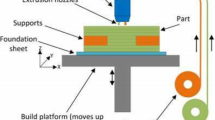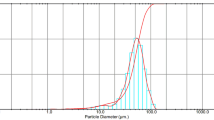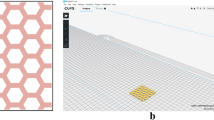Abstract
This study characterizes the microstructure and temperature dependence of resistance of two commercially available electrically conductive polylactic acid (PLA) composites for fused deposition modeling (FDM): PLA-carbon black and PLA-graphene. No microstructural changes were observed between the filament and the printed parts; however, the resistivity of the filament was found to drop by four to six times upon FDM. Also, compared to the resistivity of individual extruded wire, the resistivity of the printed parts was found to be up to 1500 times higher for PLA-graphene and up to 300 times higher for PLA-carbon black. The raw PLA-carbon black filament and printed wire showed a positive temperature coefficient of resistance (α) value between ~ 0.03 and 0.01 °C−1, which makes them more suitable for sensor development. The raw PLA-graphene filament and printed wire did not exhibit a significant α, which makes them more suitable for printing wires. However, the parts made with multilayer FDM exhibited a negative or a negligible α up to a certain temperature prior to exhibiting a positive α; further, these α values were significantly lower than those obtained for the filaments before or after extrusion. These findings enable proper selection of commercial conductive FDM filaments for enabling quicker prototyping of electronics and sensors.
Similar content being viewed by others
References
Danforth SC (1995) Fused deposition of ceramics: a new technique for the rapid fabrication of ceramic components. Mater Technol 10(7–8):144–146
Macy WD, Orrock JE (2013) Engineering product solutions enabled by fused deposition modeling. International SAMPE Technical Conference:44–58
Novakova-Marcincinova L, Novak-Marcincin J (2012) Applications of rapid prototyping fused deposition modeling materials. 23rd DAAAM International Symposium on Intelligent Manufacturing and Automation 2012 1:57-60
Bahri M, Hussain MM, Brahimi T, Dahrouj H (2017) FDM 3D printed coffee glove embedded with flexible electronic. 2017 14th Learning and Technology, Conference 49–53. https://doi.org/10.1109/LT.2017.8088126
Brunelle M, Ferralli I, Whitsitt R, Medicus K (2017) Current use and potential of additive manufacturing for optical applications. Proceedings of SPIE - The International Society for Optical Engineering 10448. https://doi.org/10.1117/12.2279824
Christ JF, Aliheidari N, Ameli A, Pötschke P (2017) 3D printed highly elastic strain sensors of multiwalled carbon nanotube/thermoplastic polyurethane nanocomposites. Mater Des 131:394–401. https://doi.org/10.1016/j.matdes.2017.06.011
Diegel O, Singamneni S, Huang B, Gibson I (2010) The future of electronic products: conductive 3D printing? In: Bartolo P, et al (eds) Proceedings of VRP4, Leiria, Portugal, pp 397–403
Goh GL, Agarwala S, Goh GD, Tan HKJ, Zhao L, Chuah TK, Yeong WY (2018) Additively manufactured multi-material free-form structure with printed electronics. Int J Adv Manuf Technol 94(1–4):1309–1316. https://doi.org/10.1007/s00170-017-0972-z
Tan N, Gu X, Ren H (2018) Design, characterization and applications of a novel soft actuator driven by flexible shafts. Mech Mach Theory 122:197–218. https://doi.org/10.1016/j.mechmachtheory.2017.12.021
Cadman D, Zhang S, Vardaxoglou Y (2017) Fused deposition modelling for microwave circuits & antennas. ISAP 2016 - International Symposium on Antennas and Propagation 418–419
Nassar IT, Tsang H, Church K, Weller TM (2014) A high efficiency, electrically-small, 3-D machined-substrate antenna fabricated with fused deposition modeling and 3-D printing. IEEE Radio and Wireless Symposium, RWS 67–69. https://doi.org/10.1109/RWS.2014.6830137
Rojas-Nastrucci EA, Ramirez R, Hawatmeh D, Lan D, Wang J, Weller T (2017) Laser enhanced direct print additive manufacturing for mm-wave components and packaging. Proceedings of the 2017 19th International Conference on Electromagnetics in Advanced Applications, ICEAA 2017:1531–1534. https://doi.org/10.1109/ICEAA.2017.8065575
Gaal G, Mendes M, de Almeida TP, Piazzetta MHO, Gobbi AL, Riul A, Rodrigues V (2017) Simplified fabrication of integrated microfluidic devices using fused deposition modeling 3D printing. Sensors Actuators B Chem 242:35–40. https://doi.org/10.1016/j.snb.2016.10.110
Helmer D, Voigt A, Wagner S, Rapp BE (2016) Rapid printing in PDMS - fused deposition modeling (FDM) meets microfluidics. 20th International Conference on Miniaturized Systems for Chemistry and Life Sciences. MicroTAS 2016:168–169
Li F, Macdonald NP, Guijt RM, Breadmore MC (2017) Using printing orientation for tuning fluidic behavior in microfluidic chips made by fused deposition modeling 3D printing. Anal Chem 89(23):12805–12811. https://doi.org/10.1021/acs.analchem.7b03228
Tothill AM, Partridge M, James SW, Tatam RP (2017) Fabrication and optimisation of a fused filament 3D-printed microfluidic platform. J Micromech Microeng 27(3):035018. https://doi.org/10.1088/1361-6439/aa5ae3
Wang H, Masood S, Iovenitti P, Harvey E (2001) Application of fused deposition modelling rapid prototyping system to the development of microchannels. Proc SPIE Int Soc Opt Eng 4590:213–220. https://doi.org/10.1117/12.454606
Ang BWK, Yeow C-H (2017) Print-it-Yourself (PIY) glove: a fully 3D printed soft robotic hand rehabilitative and assistive exoskeleton for stroke patients. IEEE International Conference on Intelligent Robots and Systems 2017-September, 1219–1223. https://doi.org/10.1109/IROS.2017.8202295
Candiotti H, Karl B, Knowles K, Mathews D, Mohen K, Hall C, Paliwal M (2013) Fused deposition modeling BioPrinter. Proceedings of the IEEE Annual Northeast Bioengineering Conference, NEBEC, 177–178. https://doi.org/10.1109/NEBEC.2013.98
Chohan JS, Singh R, Boparai KS, Penna R, Fraternali F (2017) Dimensional accuracy analysis of coupled fused deposition modeling and vapour smoothing operations for biomedical applications. Compos Part B 117:138–149. https://doi.org/10.1016/j.compositesb.2017.02.045
Jabbari E, Rocheleau DN, Xu W, He X (2007) Fabrication of biomimetic scaffolds with well-defined pore geometry by fused deposition modeling. Proceedings of the ASME International Manufacturing Science and Engineering Conference 2007, MSEC2007:71–76. https://doi.org/10.1115/MSEC2007-31011
Konieczna L, Belka M, Okoska M, Pyszka M, Czek T (2018) New 3D-printed sorbent for extraction of steroids from human plasma preceding LC–MS analysis. J Chromatogr A 1545:1–11. https://doi.org/10.1016/j.chroma.2018.02.040
Salentijn GIJ, Oomen PE, Grajewski M, Verpoorte E (2017) Fused deposition modeling 3D printing for (bio)analytical device fabrication: procedures, materials, and applications. Anal Chem 89(13):7053–7061. https://doi.org/10.1021/acs.analchem.7b00828
Cader M (2017) The estimation method of strength for technology-oriented 3D printing parts of mobile robots. Adv Intell Syst Comput 550:367–379. https://doi.org/10.1007/978-3-319-54042-9_34
Klippstein H, Diaz De Cerio Sanchez A, Hassanin H, Zweiri Y, Seneviratne L (2018) Fused deposition modeling for unmanned aerial vehicles (UAVs): a review. Adv Eng Mater 20(2). https://doi.org/10.1002/adem.201700552
Yang Y, Chen Y, Li Y, Zhiqiang Chen M (2016) 3D printing of variable stiffness hyper-redundant robotic arm. Proceedings - IEEE International Conference on Robotics and Automation 2016-June, 3871–3877. https://doi.org/10.1109/ICRA.2016.7487575
Wei X, Li D, Jiang W, Gu Z, Wang X, Zhang Z, Sun Z (2015) 3D printable graphene composite. Sci Rep 5. https://doi.org/10.1038/srep11181
Kwok SW, Goh KHH, Tan ZD, Tan STM, Tjiu WW, Soh JY, Ng ZJG, Chan YZ, Hui HK, Goh KEJ (2017) Electrically conductive filament for 3D-printed circuits and sensors. Appl Mater Today 9:167–175. https://doi.org/10.1016/j.apmt.2017.07.001
Lin YH, Yang CY, Lin SF, Lin GR (2015) Triturating versatile carbon materials as saturable absorptive nano powders for ultrafast pulsating of erbium-doped fiber lasers. Opt Mater Express 5(2):236–253. https://doi.org/10.1364/OME.5.000236
Thomsen BSRAC (2004) Raman spectroscopy of graphite. Phil Trans R Soc A 362:2271–2288
Király A, Ronkay F (2015) Temperature dependence of electrical properties in conductive polymer composites. Polym Test 43:154–162. https://doi.org/10.1016/j.polymertesting.2015.03.011
Acknowledgements
We are thankful to the staff members at the Institute for Micromanufacturing and the Center for Biomedical Engineering and Rehabilitation Sciences. We thank Chinedu Okafor, Nowzesh Hasan, and Zachary Swart for their timely inputs and feedback concerning designing the experiment and in interpreting the data.
Funding
The research reported in this publication was supported by (1) the National Science Foundation through the cooperative agreement OIA-1541079 and the Louisiana Board of Regents, (2) an Institutional Development Award (IDeA) from the National Institute of General Medical Sciences of the National Institutes of Health under grant number P20GM103424, and (3) the Research Competitiveness Subprogram from the Louisiana Board of Regents through the Board of Regents Support Fund under the contract number LEQSF (2013-2016)-RD-A-09.
Author information
Authors and Affiliations
Corresponding author
Ethics declarations
Conflict of interest
The authors declare that they have no conflict of interest.
Rights and permissions
About this article
Cite this article
Daniel, F., Patoary, N.H., Moore, A.L. et al. Temperature-dependent electrical resistance of conductive polylactic acid filament for fused deposition modeling. Int J Adv Manuf Technol 99, 1215–1224 (2018). https://doi.org/10.1007/s00170-018-2490-z
Received:
Accepted:
Published:
Issue Date:
DOI: https://doi.org/10.1007/s00170-018-2490-z




